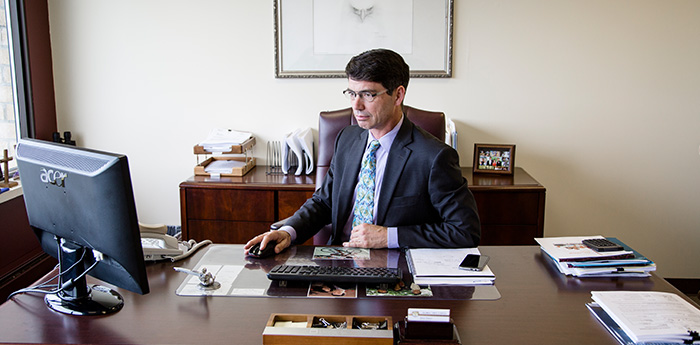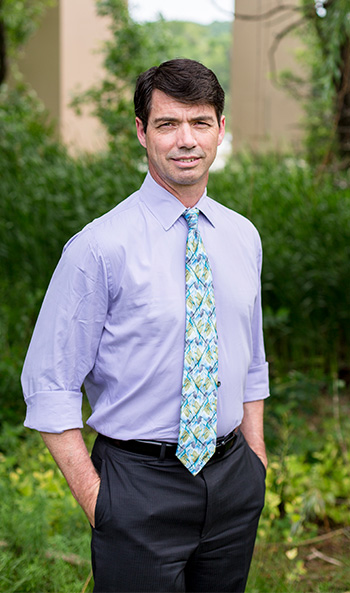The sacred trust
The sacred trust

James Hamer • Waukesha, WI
Global View Capital Management
James Hamer can certainly be called a well-rounded guy. His professional development includes the sciences, teaching, and—of course—financial services. His personal interests range from cycling to yoga to ballroom dancing. But when it comes to client relationships, he’s got just one thing on his mind: honoring their sacred trust—which begins with frank discussions about expectations and managing risk.
Proactive Advisor Magazine: James, can you describe your client philosophy?
I have been in the financial industry for 26 years and really have never wavered from why I started in the advisory business. I have a passion for helping people learn about managing their money and not to be intimidated by the world of finance.
Money management is far from easy, but it should be something that a good advisor can simplify to make understandable. My goal is not only to educate but to make sure people can sleep at night, knowing they have a good financial plan in place. I believe in some of the concepts Steve Jobs used to make Apple so successful. He understood he was not just selling a product but also an experience. I want my clients to have a financial life that is as free of stress as possible.
How does this play out in your investment approach?
Back when I first started my career, I followed a pretty traditional investing approach for clients—primarily mutual funds, asset allocation modeling, and diversification. I like to think we did that at a pretty high and sophisticated level, but it was still very much a passive approach to investing with periodic rebalancing.
With the first crash of the early 2000s, I saw both my personal portfolio and those of my clients essentially cut in half. Yes, there was a slow rebound, but I still had to field many calls from clients and give reassurances that things would work out over the long haul. It sounds OK when you are talking about long-term trends and market history that there would be a recovery in client assets, but when you actually look at account balances down 20%-40% that is another matter. For many people, that represents a very significant portion of their retirement nest egg.
That was the trigger point for me, and we started investigating money managers who employed active management strategies.

How has that process evolved over time?
It really started around 2004 when we introduced our first active manager to client portfolios. That first strategy experience worked well in certain markets and not so well in others. This put our organization to the test, and we in turn put active managers to the test.
There are excellent third-party managers out there with a wide variety of philosophies, and it is a matter of conducting the due diligence and selecting strategies that you think are going to be appropriate for your client base. Since this almost always involves a fee structure for clients, it was a new way of doing business and places a great responsibility on the advisor to make a very careful selection of managers—including making changes in the roster of managers, if necessary.
At the top of my list is setting expectations with clients about active management and how it works. Once we have the appropriate longer-term expectations in place, it has been by and large a successful approach for our practice.
Talk about how you manage client expectations.
 It really goes back to what I said about how I approach working with clients. This business should be about alleviating concerns about money, not adding to them. Clients are affected by everything they read and hear from the media. Active management provides an investment approach where they can be assured that very professional money managers are monitoring the market environment on their behalf every day. That does not mean changes are going to made every day—far from it—but these managers have the ability and the strategies to anticipate and react to changes in market conditions.
It really goes back to what I said about how I approach working with clients. This business should be about alleviating concerns about money, not adding to them. Clients are affected by everything they read and hear from the media. Active management provides an investment approach where they can be assured that very professional money managers are monitoring the market environment on their behalf every day. That does not mean changes are going to made every day—far from it—but these managers have the ability and the strategies to anticipate and react to changes in market conditions.
As part of its underlying principle, active management has a strong emphasis on risk management, which usually has two major implications for clients. First, that the risk of those large portfolio drawdowns seen in the early 2000s and 2008 can be mitigated. Secondly, on the flip side, when markets are running very hot to the upside, actively managed strategies—not all, but some—may not see all the gains of the market.
I have very frank discussions with clients about their individual risk profiles, the strategies we are recommending to employ, and how those strategies should fit in their overall financial plan. This is the challenge for us as advisors. We need to communicate and explain very sophisticated, quantitative strategies to average investors. They do not need to know everything that is under the hood, but they do need to fully understand and agree to the overall objectives. They especially need to understand that the majority of actively managed strategies are not designed to track overall market benchmarks.
That is the whole point—to have less-correlated strategies with lower volatility and more risk management. The money managers we are using now are genuinely more tactical, with the ability to go wholly or in part to cash or to use inverse or leveraged strategies. This is diversification taken to another level, with diversification among asset classes and then tactically managing exposure within an asset class.
Do you find issues in introducing active management to clients?
As I mentioned, there is the education piece. We have some very good materials on market history and the historical performance of actively managed portfolios versus the performance of more passive portfolios. While this has to be positioned with care and all appropriate disclaimers, it is a pretty powerful story.
We need to be very upfront about the fees involved with third-party active management. In the big picture, these are not high by any means. But for some clients it is a new factor to be introduced and explained.
We also place great importance on client reviews and ask for feedback on every aspect of our performance. Returns are top of mind for many clients, and there are times when some actively managed strategies may not be performing as well as we would like. The critical factor is whether or not our managers are executing their strategies well. If they are but the performance is still consistently not living up to our expectations, we will make strategy changes. We need to set the expectation of that possibility with clients, and, hopefully, it is the exception and not the rule.
Bottom line, active management is a great fit for my philosophy of working with clients—it has become part of my belief system. I want to set clear, realistic, and achievable expectations with clients and provide a high level of risk management. Clients place a sacred trust with us, and at the end of the day what matters most is acting in the best interest of the client. That means earning that trust every step of the way—from education to planning to implementation to review.
Disclosure: Advisory services offered through Global View Capital Management, Ltd., an SEC-registered investment advisory firm.
Photography by Sara Stathas

